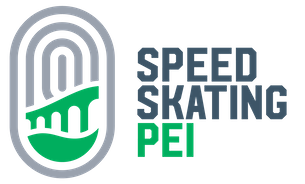The following table outlines the required equipment and any differences between the different programs.
Speed Skating PEI Equipment Requirements
-
Skates
For Learn to Skate, hockey skates are ideal, but figure skates are also allowed. As skaters progress to the Learn to Speed Skate program, long blades are introduced and encouraged, to avoid falling behind other skaters. Long blades are mandatory for participation in the Intermediate and Advanced Speed Skating programs. If you have not already but want to move to long blades, please discuss it with your coach. You may purchase your own skates or rent from the club. If you are interested in purchasing your own skates or blades, please discuss this with your coach. -
Helmet
A helmet must be worn for all on-ice activities. It must be securely fastened under the chin at all times. A skate blade should not be able to penetrate any ventilation holes in the helmet. For Learn to Skate and Learn to Speed Skate Programs, helmets must be ASTM F 1849 certified or CSA approved (hockey, snowboard/ski or skateboarding helmets only). For all other competitions and activities, helmets must be ASTM F 1849 certified. For skaters in our Intermediate and Advanced programs, this means that speed skating helmets must be used. Speed Skating Canada (“SSC”) and International Skating Union (“ISU”) rules state that these helmets must be worn in all SSC or ISU sanctioned meets. If you purchase one when your child is young, it will normally last for many years. -
Eye Protection
Eye protection (safety glasses or hockey mask / cage) is mandatory for all skaters. For Learn to Skate, full face protection in the form of a hockey mask is the recommended form of protection. For skaters participating in our long blade programs, sport glasses certified for use in racquetball or squash are the recommended way to meet the mandatory eye protection requirements. All glasses or goggles must be held on with a strap. -
Bib style Neck Guard
Bib style hockey neck guards are required. The neck guard must be cut resistant, made of ballistic nylon, Kevlar or Dyneema material and must cover the neck and upper chest area. -
Cut Resistant Gloves
Cut resistant gloves must be worn. Padded ski gloves (for younger skaters), leather gloves, or various speed skating gloves are acceptable. Kevlar or Dyneema lined leather gloves are the best for competitive skaters. Wool, cotton or nylon are not acceptable. -
Knee Pads
Knee pads are required for all skaters. Soft volleyball-style knee pads or speed skating knee pads are preferred. Skaters in Learn to Skate can wear bike or roller blading knee pads to start. -
Shin Guards
Shin pads are required in all programs except for our Learn to Skate program. Hard plastic soccer shin pads are normally used and the type without the attached ankle guards are recommended. They should be worn under the clothes. Do not purchase shin pads that are soft or with the hard plastic in strips. -
Ankle Protection
Ankle guards made of Kevlar or Dyneema material are required for all programs with long blades and for all sanctioned competitions. These fabric tubes are worn on both legs outside of skinsuits (or other clothing) and should cover from the top part of the skate boot to at least 4 inches above the top of the boot. The tubes should be reasonably snug so that they don’t fall down from the skater’s leg. Ankle guards can be purchased from Speed Skating PEI for $15 per pair. -
Elbow Pads (Optional)
Elbow pads are strongly recommended for the Learn to Skate program — these skaters tend to fall on their elbows. Hockey or rollerblading elbow pads are both fine. Older skaters don’t need them. -
Clothing
For Learn to Skate participants, warm, stretchy clothing is best. Nylon wind pants will help keep skaters dry. Skaters in the Learn to Speed Skate programs should wear stretchy clothing such as a track suit or sweat pants. Long sleeves are always mandatory. In the Intermediate and Advanced programs, skaters generally wear some form of skin suit and a long or short-sleeved t-shirt at practices. Full skin suits are normally worn by all experienced competitive skaters in competition, but are not required starting out. If you are wondering what is best to wear, watch or talk to some of the older skaters. Frequently, second-hand skin suits can be purchased or else a group will order skin suits together from one of the manufacturers in Canada.
All required equipment must be worn at every practice. Skaters with incomplete equipment will not be permitted on the ice for safety reasons.
